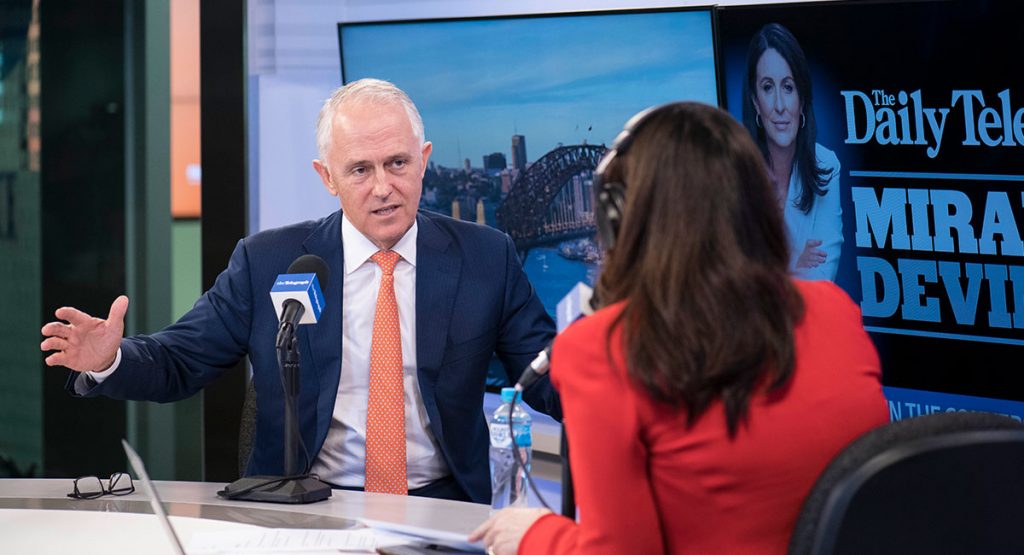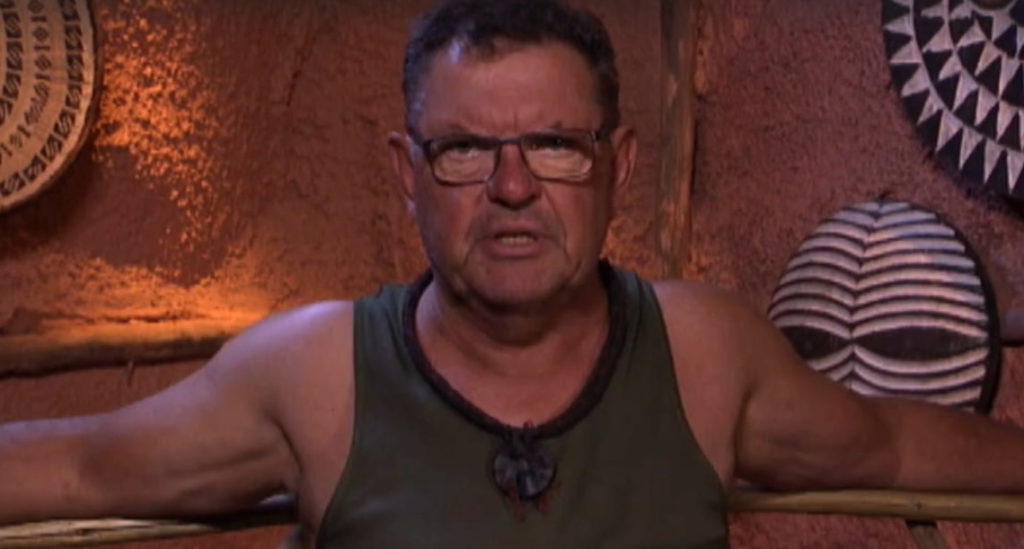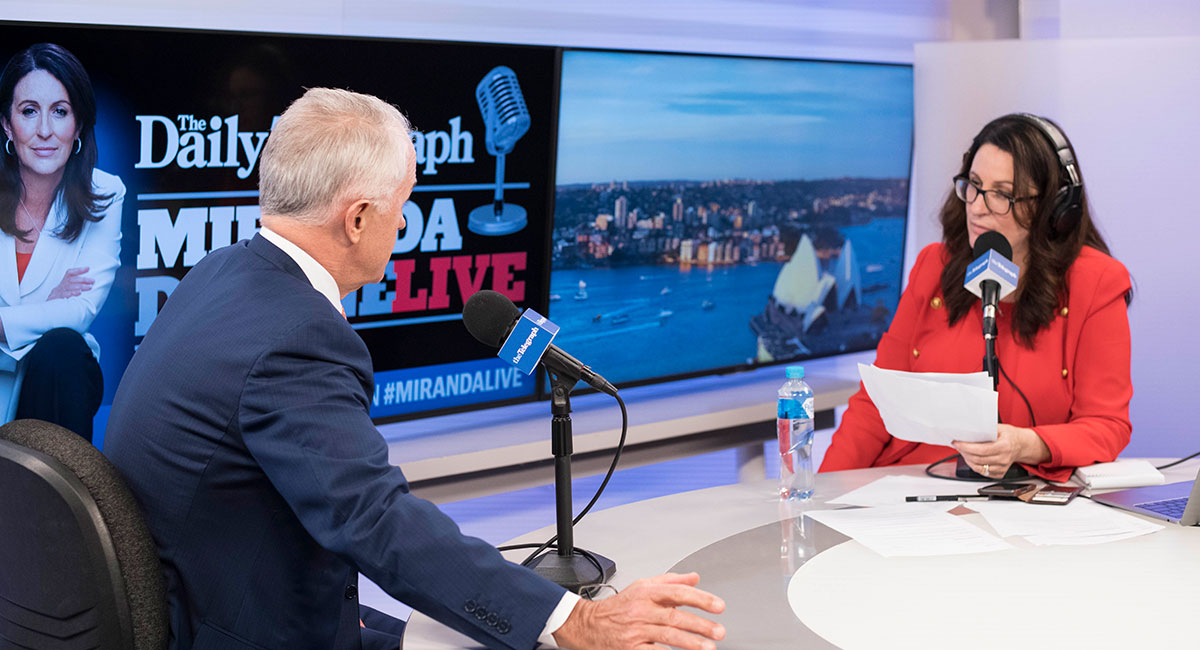The Daily Telegraph’s first internet radio show, Miranda Live, is a test for what the masthead could do in the audio space in the future.
The show is streamed live on Whooshka and Facebook Monday to Wednesday and presented by well-known columnist Miranda Devine.
Mediaweek recently paid a visit to the News Corp building in Sydney to see how it all comes together. The third floor of the building is home to The Daily Telegraph and a small TV studio facility that was temporarily used by Sky News Business while its new state-of-the-art facility was being built on the ground floor of the News Corp building. The compact studio space features two control rooms, a small vanity room and the actual studio space with multiple cameras surrounding the desk. The facility is now used to film and produce Miranda Live as well as a host of other podcasts and shows coming from The Daily Telegraph.

PM Malcolm Turnbull on Miranda Live
The show usually has three producers working behind the scenes, but on the day of Mediaweek’s visit, the third producer Chris Bowen was away. The show’s other two producers Dani Pogson and James Morrow seemed frantic.
Bowen and Pogson previously worked at 2GB. The company’s head of strategic planning Zac Skulander told Mediaweek they were recruited by News Corp to make Miranda Live sound and feel like a professional radio show and podcast. Skulander was helping Pogson and Morrow with the show on the day of our visit. Miranda Live is the brainchild of Skulander and The Daily Telegraph editor Christopher Dore.
Devine walked into the studio space with a laptop and mobile in hand at about 3:45pm, 15 minutes before the show was scheduled to go on air. “I need to get this column done,” she said. It’s deadline day and the first of Devine’s two weekly columns was to be printed in the next day’s paper.
At 4pm a producer started to count down from 10 into a mic linked to Devine’s headphones in the other studio and the show was live. “Good afternoon and welcome to Miranda Live,” Devine said as she opened the show for Tuesday April 17.

Daily Telegraph editor Chris Dore
The next hour was a whirlwind with guests coming in and out, and calling in to the studio. There was also a breaking news story about a chopper crash at Kosciuszko National Park, which Devine broke during the show. The internet radio show is comparable to any live talkback radio show, Skulander said. It covers the day in news and has the ability to break news on air. Skulander enjoys this aspect, but admits that News Corp is still testing with the format. He is re-considering the live aspect of it. The main purpose of the show is to use the journalists and talent that News Corp has. “Our journalists often go on other TV shows and radio shows to talk about a story that they’ve done,” he said. “We want to own our content.” The internet radio show and other podcasts are a way of doing exactly that.
Why was Miranda Devine chosen to host The Daily Telegraph’s first live afternoon show? Skulander said the decision was made off the back off the success Devine had when she filled in for Macquarie Media’s Steve Price in 2017, when Price was away filming for Ten’s I’m A Celebrity Get Me Out Of Here! “She not only maintained the show’s audience but also grew in it some markets,” Skulander said.
As soon as Miranda Live wrapped up for the afternoon, Devine made her way to the control room where the rest of the team was seated. “Good show today,” she said. She and the producers then quickly discussed what segments worked well. The discussion around the Greens’ push to legalise pot dominated much of the hour, the team agreed. Counting the live streams on Facebook and Whooshka and podcast downloads, each episode of Miranda Live is heard on average 25,000-30,000 times.

Steve Price on I’m A Celebrity…Get Me Out Of Here!
Mediaweek also spoke to Devine on the morning after the show. “The show is an extension of my column in a lot of the ways,” she said. “It is quite useful. I can interview people and then write columns about them or I can do my columns and then interview people on the show.”
Devine’s columns are known to be provocative – she has her supporters and critics. “Mainly, my opinions resonate with the people who read my column,” Devine said. “I just accept the criticisms. You can’t be talking about important things that people are divided on or have different opinions on without getting pushback. Otherwise, you are just bland and boring. No one reads you. The whole point of having an opinion is that someone is going to get offended by it – especially in this day and age. Everyone is offended by everything.”
In her private sphere, Devine isn’t known to be particularly opinionated. “If you talk to my friends, they don’t think I am opinionated,” she said. This is starkly different to her public persona as a journalist and a columnist. “This is my job,” she said, agreeing. “This is my professional persona. Your professional persona is not really your private persona, is it?”
Devine comes from a family of journalists. Both of her parents worked in the industry. She spent much of her childhood in the US. Devine’s father was once the editor of Reader’s Digest before going on to work for Rupert Murdoch’s News Corporation in the States. “I have always wanted to be a journalist,” Miranda Devine said. “But my parents tried to talk me out of it.” [Laughs]
Her parents asked her to get a degree first. If she still wanted to work as a journalist at the end of it, they offered to pay for her fees to study.
Devine did exactly that. She initially studied science majoring in mathematics before going on to study journalism. She applies the idea of proof in maths to her articles. “In maths, you have to prove something using logic and mathematical reasoning. At the end of your proof, you write Q.E.D. That’s what I try to do with my columns. I take people along a logical journey to make them understand where I am coming from. They might still disagree, but at least they can’t say I haven’t thought it through.”
